Intel's 10nm Cannon Lake and Core i3-8121U Deep Dive Review
by Ian Cutress on January 25, 2019 10:30 AM ESTStock CPU Performance: Encoding Tests
With the rise of streaming, vlogs, and video content as a whole, encoding and transcoding tests are becoming ever more important. Not only are more home users and gamers needing to convert video files into something more manageable, for streaming or archival purposes, but the servers that manage the output also manage around data and log files with compression and decompression. Our encoding tasks are focused around these important scenarios, with input from the community for the best implementation of real-world testing.
All of our benchmark results can also be found in our benchmark engine, Bench.
Handbrake 1.1.0: Streaming and Archival Video Transcoding
A popular open source tool, Handbrake is the anything-to-anything video conversion software that a number of people use as a reference point. The danger is always on version numbers and optimization, for example the latest versions of the software can take advantage of AVX-512 and OpenCL to accelerate certain types of transcoding and algorithms. The version we use here is a pure CPU play, with common transcoding variations.
We have split Handbrake up into several tests, using a Logitech C920 1080p60 native webcam recording (essentially a streamer recording), and convert them into two types of streaming formats and one for archival. The output settings used are:
- 720p60 at 6000 kbps constant bit rate, fast setting, high profile
- 1080p60 at 3500 kbps constant bit rate, faster setting, main profile
- 1080p60 HEVC at 3500 kbps variable bit rate, fast setting, main profile

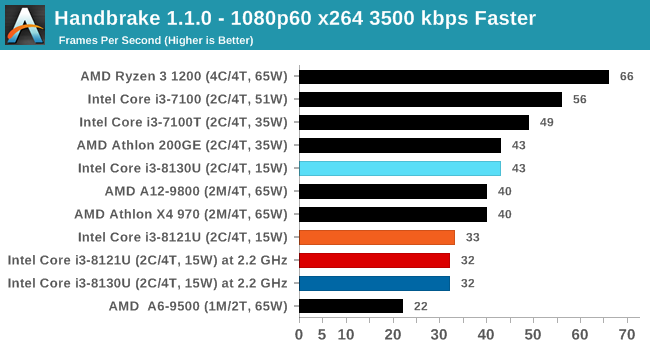
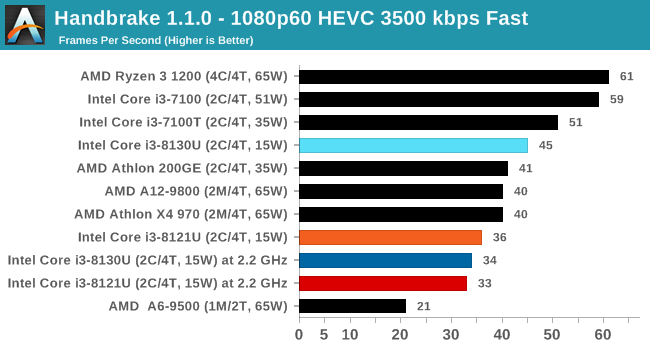
7-zip v1805: Popular Open-Source Encoding Engine
Out of our compression/decompression tool tests, 7-zip is the most requested and comes with a built-in benchmark. For our test suite, we’ve pulled the latest version of the software and we run the benchmark from the command line, reporting the compression, decompression, and a combined score.
It is noted in this benchmark that the latest multi-die processors have very bi-modal performance between compression and decompression, performing well in one and badly in the other. There are also discussions around how the Windows Scheduler is implementing every thread. As we get more results, it will be interesting to see how this plays out.
Please note, if you plan to share out the Compression graph, please include the Decompression one. Otherwise you’re only presenting half a picture.
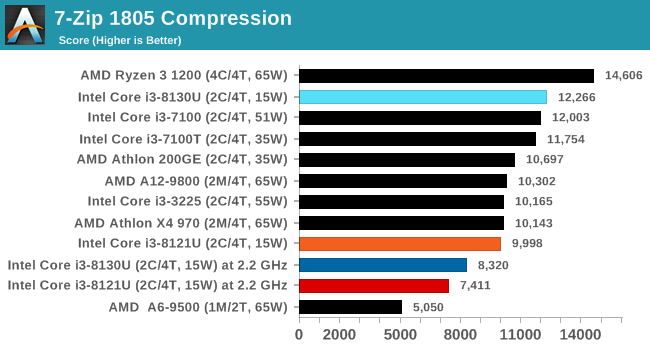


WinRAR 5.60b3: Archiving Tool
My compression tool of choice is often WinRAR, having been one of the first tools a number of my generation used over two decades ago. The interface has not changed much, although the integration with Windows right click commands is always a plus. It has no in-built test, so we run a compression over a set directory containing over thirty 60-second video files and 2000 small web-based files at a normal compression rate.
WinRAR is variable threaded but also susceptible to caching, so in our test we run it 10 times and take the average of the last five, leaving the test purely for raw CPU compute performance.
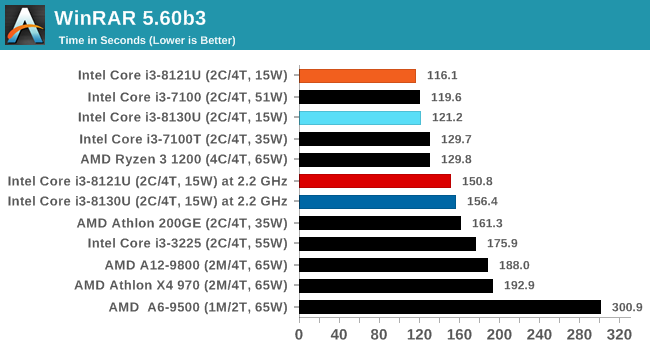
AES Encryption: File Security
A number of platforms, particularly mobile devices, are now offering encryption by default with file systems in order to protect the contents. Windows based devices have these options as well, often applied by BitLocker or third-party software. In our AES encryption test, we used the discontinued TrueCrypt for its built-in benchmark, which tests several encryption algorithms directly in memory.
The data we take for this test is the combined AES encrypt/decrypt performance, measured in gigabytes per second. The software does use AES commands for processors that offer hardware selection, however not AVX-512.
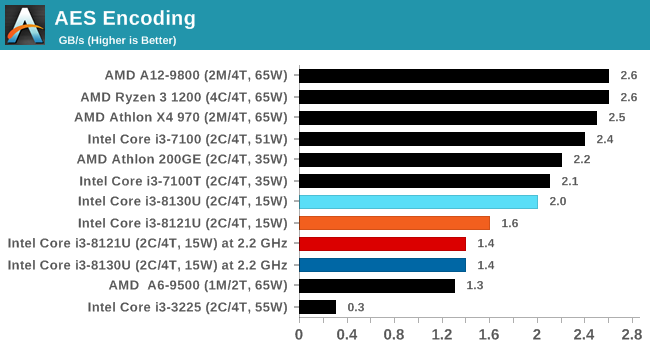










129 Comments
View All Comments
MrCommunistGen - Friday, January 25, 2019 - link
Normally I try to read the whole article (and I *am* looking forward to reading the rest of it) but I already have 2 comments:1. Maybe this review has been in progress for quite a while, but you can definitely buy the NUC8i3CYSM NUC on Amazon, at least in the US. It is shipped and sold by Amazon not some random 3rd party too. It is expensive ($530), and can only be bought with up to 8GB of soldered down RAM, but you can buy it.
2. While the Wi-Fi card is M.2, Lenovo (like HP and others) usually restricts what Wi-Fi cards can be used with a BIOS/UEFI whitelist. I guess this might not apply to a China-only model, but I wouldn't just assume that the card can be upgraded down the line unless you've already verified this is possible.
jaju123 - Friday, January 25, 2019 - link
I would chalk up the system resonsiveness to the GPU and the low screen res. When moving from a Dell XPS 15 9560 laptop with 1080p screen resolution to an otherwise identical 4K model, I noticed a severe loss of performance in the windows UI. The reality is that Intel iGPUs in even kaby lake processors are simply not enough to provide a smooth experience on high res laptops. The 1080p experience was really smooth, however.You can also force certain apps to the use the dedicated nvidia graphics, or simply choose to run at a non-native 1080p and it speeds up the UI drastically.
hansmuff - Friday, January 25, 2019 - link
Wow, this is an excellent article. Packed with knowledge and facts, well written; a real gem. Thank you!FreckledTrout - Friday, January 25, 2019 - link
Its weird to see a dual core even in a laptop on the new 10nm process. I would have expected dual cores to disappear with Intel's 10nm or AMD's 7nm.FreckledTrout - Friday, January 25, 2019 - link
The first dual core laptop came out in 2015 with the AMD Athlon 64 X2 4800 so it's just weird to me 14 years later it's still something being made especially with such a dense process.FreckledTrout - Friday, January 25, 2019 - link
Damn no edit.... in 2005 I meant.jeremyshaw - Friday, January 25, 2019 - link
I think I had one of those in a Sharp laptop. It had horrible VIA S3 graphics, but a beautiful, bright display. It was my last 4:3 laptop, an end of an era for me.Icehawk - Saturday, January 26, 2019 - link
Majority of laptops are still DC, I have to check our laptop orders when we place them to make sure my boss and our vendor aren’t screwing up ordering them.ianmills - Friday, January 25, 2019 - link
Intel probably thought the same as you! Remember the reason this was released was so that Intel could tell its investors it was shipping 10nm partsdanwat1234 - Friday, January 25, 2019 - link
Agreed.